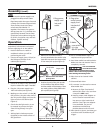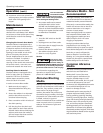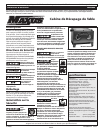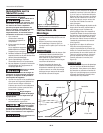
4
O
perating Instructions
www.maxustools.com
16. A common wire screen placed on
c
abinet grating can help to prevent
small items from getting lost in
hopper.
Maintenance
Cleaning
The plastic door cover should be
cleaned with a soft damp cloth. NEVER
use solvents to clean plastic parts. They
could dissolve or otherwise damage
the material.
Changing the Ceramic Gun Nozzle
The blast cabinet is equipped with a
ceramic nozzle that controls the flow
of abrasive media as it exits the spray
gun. The nozzle creates a smaller
opening for the media to exit which
gives a finer spray that easier to
control. Replacements for the ceramic
nozzle are included. To replace a
nozzle, unscrew the outer metal
covering of the nozzle and remove the
old ceramic nozzle. Insert the new
nozzle and reattach the metal cover.
Draining Abrasive Material
The blast cabinet is equipped with a
drain for easy clean up of abrasive
materials. The floor of the blast
cabinet tapers toward the center,
where the drain is located.
In order to remove blast media:
1. Make sure the air supply is
disconnected before doing any
draining.
2. Secure the cabinet in an elevated
position that allows room for a
container below the plug.
3. Place a container within 4 inches of
the drain opening.
4. Pull the plug from the drain and
allow media to drain from cabinet.
DO NOT shake cabinet. Shaking the
cabinet could cause the media to
spill and create dust that could be
hazardous if breathed.
You can create dust
when abrasive media
is poured into or drained from the blast
cabinet. Wear a mask and eye protection
when draining the blasting media.
5. Any excess media can be moved
toward the drain with a brush.
DO NOT use the blasting gun to
blow air to drain the abrasive media.
Doing so can create dust that could
be hazardous if breathed.
Storage
1. Turn ON / OFF switch to the OFF
position.
2. Unplug power cord from outlet.
3. Disconnect the air supply from the
blasting cabinet
4. Remove the abrasive media from
the cabinet using the drain.
5. Store in a cool, dry place.
Service
Tool service must
be performed only
by qualified repair personnel and by an
AUTHORIZED SERVICE CENTER. Service or
maintenance performed by unqualified
personnel could result in a risk of injury.
For information regarding the
operation or repair of this product,
please call 1-800-424-8936.
Abrasive Blasting
Media
Blasting media comes in many different
grit sizes and sometimes is also rated as
extra fine, fine, medium, coarse, and
extra coarse. The larger the grit
number, the smaller the particle size;
the smaller the grit number, the larger
the particle size. Glass media can come
in beads, crushed, or ground.
Aluminum oxide and silicon carbide can
come in several colors. It is common
today to find mixtures of glass and
aluminum oxide.
Abrasive Media - Not
Recommended
Although available, some media are
not recommended for use because of
m
echanical and/or personal hazards.
Silica sand, a common blast media, has
health risk concerns due to the silica
c
ontent. Restriction on its usage is
common in many states.
B
each sand (play sand) is a common
and inexpensive blast media. This
highly aggressive media can have
debris mixed in which will cause
clogging of equipment.
Steel grit produces ideal surface
preparation on new coating. This
media should only be used in a special
blast cabinet designed for this media.
Steel shot, a round, solid particle,
leaves a dimples in a surface after
blasting. It is a very dense media and
should only be used in a special blast
cabinet designed for this media.
Common Abrasive
Media
The more commonly available media
and their uses are listed below.
Walnut shell is one of the most
versatile organic media due to its
angular, durable shape. It is still
considered a soft media, but it is good
to use on delicate parts. Use as an
economical, bio-degradable alternative
for sensitive blasting that will not
scratch or damage surfaces.
Glass beads are the most popular all-
purpose media used today. Used for
honing, polishing, peening, blending,
finishing, removing light burrs, frosting
glass, and cleaning most light materials.
Common uses in the removal of paint,
rust, and surface residues. Glass bead
blasting generally will not change the
dimensions of the item being blasted.
Glass beads produce brighter finish than
angular abrasives. Beads can be recycled
and used many times.
Operation (cont.)


















